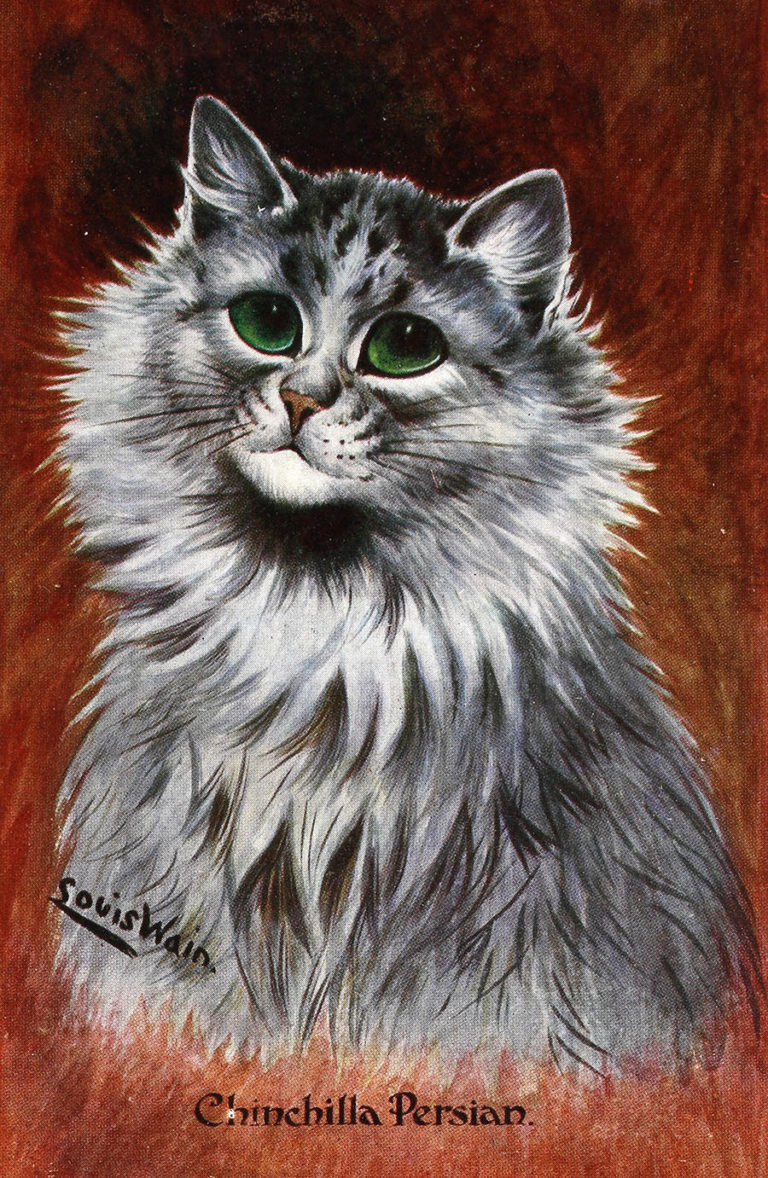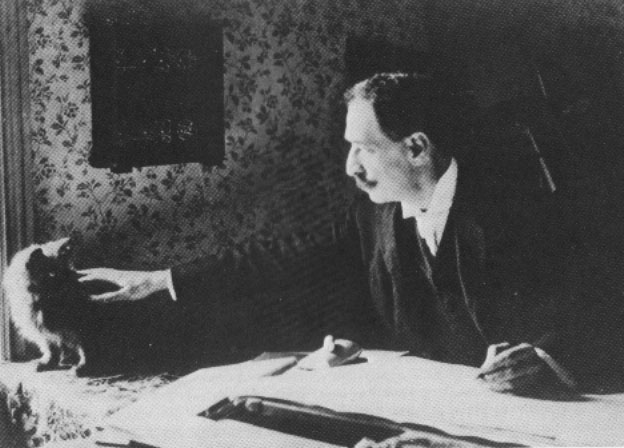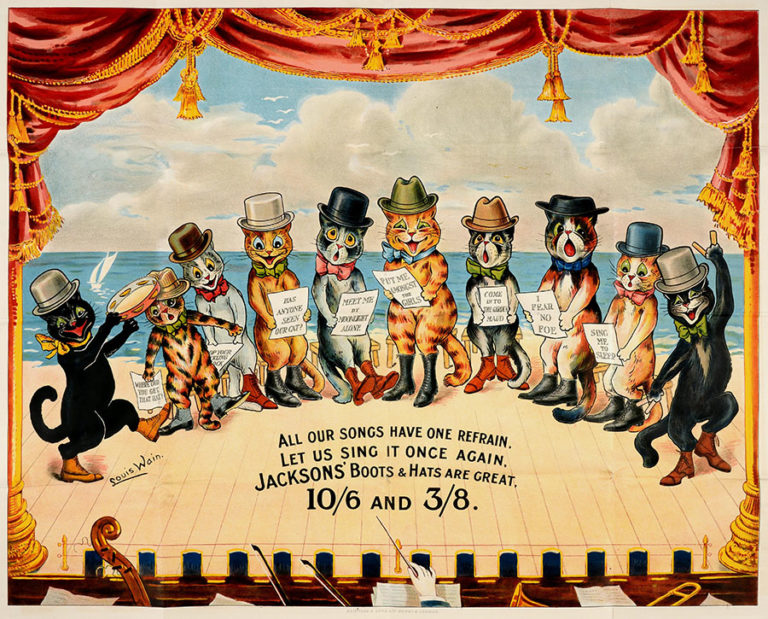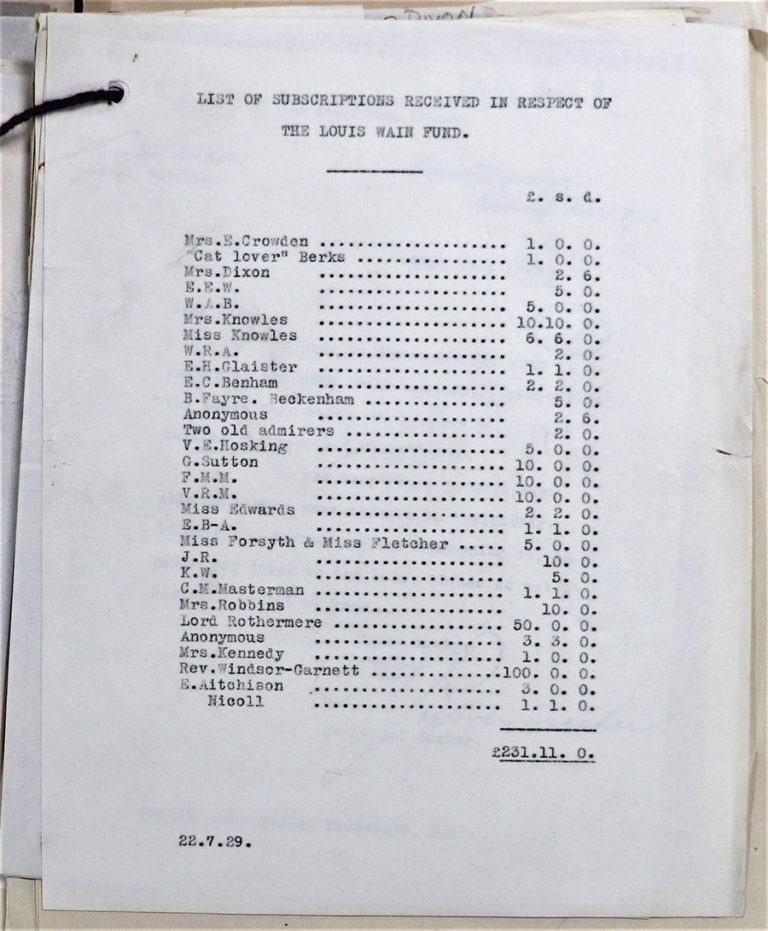Today is International Cat Day and to celebrate our feline friends, I want to focus on a man who was instrumental in changing the way we look at cats.
Louis Wain was an artist who achieved great fame and success in the late 19th and early 20th centuries for his drawings of anthropomorphic cats. He was born in London in 1860 and attended the West London School of Art. He started out his career drawing animals and country scenes for publications such as The Illustrated Sporting and Dramatic News[ref]‘Cute Cats and Psychedelia: The Tragic Life of Louis Wain’, Illustration Chronicles, https://illustrationchronicles.com/Cute-Cats-and-Psychedelia-The-Tragic-Life-of-Louis-Wain [accessed 30/07/2020][/ref]. But cats were always his first love.

Wain began selling his cat illustrations to The Illustrated London News. His first in 1884 is called ‘Our cats: A domestic history’ and was a much more realistic depiction than his later works. In 1886, Louis Wain was commissioned to illustrate a children’s book by Caroline Hughes (under the pen name Kari) titled ‘Madame Tabby’s Establishment’. In the same year, he published another illustration in The Illustrated London News titled ‘A Kitten’s Christmas Party’, showing kittens engaged in various human activities including making speeches and playing games[ref]Ibid.[/ref]. Wain’s cats became more and more human-like and expressive as his career progressed.
While these early works propelled Louis Wain to commercial success, they were inspired by personal tragedy. His wife, Emily Richardson, had become ill soon after their marriage in 1883 and he began drawing their cat, Peter, to help to cheer her up. These drawings must have brought Emily great happiness and she encouraged her husband to publish them. Sadly she died before she could celebrate the great successes of his career, in January 1887.
Louis Wain later said of Peter, who had been a stray, ‘to him, properly, belongs the foundation of my career, the developments of my initial efforts, and the establishing of my work.’[ref]Dale, Rodney, Louis Wain: the Man who Drew Cats, (Kimber, 1968), pp. 10-12[/ref]

Wain was a prolific illustrator, producing hundreds of designs a year for magazines, newspapers, children’s books and picture postcards. He also published his own ‘Louis Wain Annual’, which ran from 1901 to 1915.
His cats were often dressed in contemporary clothes partaking in the pastimes of the day such as playing cricket, smoking and reading newspapers. His cute and comical depictions caught the Victorian and Edwardian imagination. They also helped to securely cast the cat in the role of lovable indoor pet, where before it had been perceived as more of a farm animal.
American audiences also warmed to Wain’s cats and between 1907 and 1910, he contributed a cartoon strip for the Hearst’s New York Journal-American. His success was such that it was stated in The Times that ‘it may be safely said that his name was known in nearly every British household’[ref]‘Mr. Louis Wain’, The Times, 7 July 1939, Issue 48352, p. 16, GALE|CS270218471[/ref]. H G Wells supposedly said of him: ‘He has made the cat his own. He invented a cat style, a cat society, a whole cat world. English cats that do not look and live like Louis Wain cats are ashamed of themselves.’


We hold a range of Louis Wain’s illustrations in our collection at The National Archives. As a commercial artist, Wain submitted some of his illustrations to the Stationers’ Company for copyright protection and so these examples can still be found among our COPY 1 records. The records include portraits of individual cats and humorous cartoons.
Wain also produced artwork to be used for advertising purposes for commercial companies, and our collection includes some of these advertisements. Many of these images are digitised in our image library. For more information about copyright records, please see our research guide on the subject.

Louis Wain was not just an illustrator of cats, but he was a true cat-lover. He was president of the National Cat Club, a member of the Society for the Protection of Cats, and a judge at several National Cat Shows. At the National Cat Show at Crystal Palace in 1892 it was reported that the best cat in show was awarded a gold medal and a humorous drawing of cats by Louis Wain[ref]’The National Cat Show’, The Standard, 19 October 1892, Issue 21307, p. 3, GALE|GS3215103192[/ref].
Sadly, Wain suffered with mental health problems throughout his life and it seems that these worsened after the death of his wife in 1887. Understanding of mental health at the time was poor, so the exact nature of his condition is unclear, but it is thought that he may have been suffering from schizophrenia as well as anxiety and depression.
It is sometimes suggested that one can see the deterioration in Wain’s mental health in his drawings, which became more abstract and stylised over his career. However, this interpretation may be a little simplistic. Wain did continue to draw in a more traditional way during this period, and his abstract style may have simply been the result of experimentation. Wain’s drawings may be an expression of his personality as a whole, his mental health problems being just one aspect of this personality.

He made errors of judgement when it came to business. He often sold his drawings outright and earned nothing from their republication. This led to his descent into poverty, despite the continued popularity of his work.
With his mental health worsening, his sisters eventually committed him to the pauper ward of London’s Springfield Mental Hospital in 1924. He was discovered there a year later and a campaign was started to raise funds for his care. This was widely reported in the newspapers and supported by H G Wells and Prime Minister Stanley Baldwin among others.
One article in the Times reads:
An appeal is being made by animal lovers and admirers of the work of Mr. Louis Wain, who as delighted thousands with a long series of inimitable cat studies from the year 1883 onwards till recent years, to enable him to be removed from the pauper wards of a metropolitan mental asylum, where he has been apparently for some years[ref]’Mr. Louis Wain’, The Times, 12 August 1925, Issue 44038, p. 9, GALE|CS153164044[/ref].
The campaign succeeded, raising sufficient funds to move Wain to the Bethlem Royal Hospital, and then in 1930 to Napsbury Hospital near St Albans in Hertfordshire. Wain’s final years were spent in much more pleasant surroundings. The fund also provided for his elderly sisters, who were also living in poverty.

The story of Louis Wain’s life is a fascinating one full of contradictions. He spent his life celebrating his love of the cat, promoting its welfare and sharing his creativity with the world. At the same time, his life was at times dark and difficult: he suffered with mental health problems and was exploited commercially leading to terrible poverty.
His experience raises interesting questions about art, ownership, mental health, poverty and charity in the 19th and 20th centuries. And we must always remember, especially today on International Cat Day, that our present-day infatuation with the cat is partly down to the wonderful work of Louis Wain.
It seems that there has been a blossoming of interest in the work of Louis Wain in recent years. There is currently a film in production starring Claire Foy and Benedict Cumberbatch. It tells the story of Louis Wain’s life and is due for release this year.
On the Record: series four available now
In our latest three-part podcast series we explore stories in our collection with the theme of heroic deeds. In the episodes you’ll hear about spies parachuting into enemy territories and knights slaying dragons. You’ll also hear about health inspectors trying to improve the living conditions of poor Londoners and leaders using their skills to organise for change.
In episode three we explore the story of Louis Wain and his cats further, as well as that of Dick Whittington and First World War nurse Nellie Spindler.
Subscribe: iTunes | Spotify | RadioPublic | Google Podcasts
Amazing man is counterpart to so many geniuses who were impoverished whilst pursuing their art. Amongst great in the company of such as Vincent Van Gogh, who through poverty n nutrition lacks did also suffer from mental problem. So heartening his loyal followers cared for him n his sisters!
A very interesting piece.
Just a quickie, but it’s important: the newspaper’s title is
The Illustrated London News – NOT The London Illustrated News.
Thanks, and keep up the good work!
Thank you Francis!
Louis Wain is remembered in the London borough of Brent, where he lived, by two colourful and imaginative mosaics inspired by his work. Louis the cat, the first one, is on the side of the railway bridge, directly opposite Willesden Green station; the other, Eartha, is on the wall outside the large Sainsburys in Poplar Ave just off the High Road. The two public art works were created by local community workshops .
Thank you Sandra Westbrooke! I will have to track the mosaics down!
I have admired Louis Wain’s work for years and now I know more about him.
I was saddened to learn about his mental health and poverty.
Katherine, Thank you so much or a informative and interesting blog!
I have admired Louis Wain’s art for a long time and did not realise that some of his illustrations can be found in Archive files. Thanks also for pointing out that other of his illustrations can be found in the digital library link.
Thanks so much for this wonderful information about Louis Wain, his life and work. How sad that this creative genius who also did so much for the welfare of cats, suffered so much trauma and tragedy in his life.
Can Sandra give us a link so we can look at the two murals? We might then be able to arrange more such murals: why should cats be confined to Brent?
Hel;lo, I am a great fan of Louis Wain’s work with cats, and a cat lover too. I am also a Trustee of The Wellington Trust, a WW2 ship moored on the River Thames and a national treasure being the only WW2 convoy escort surviving today. We run educational programmes and I want to run a competition for children to send in photos of their cats to be voted as ship’s cat for a year. So, I am looking for information on ships cats in the past. Do you think you would have anything?
I too am a lover of cats and Louis Wain’s work having several displayed on my walls. I also have one as my screensaver that my late son found for me. I shall await the film with interest.
Many thanks for details of this exhibition. I wonder if it is possible for such exhibitions to be displayed in Bristol as we always seem to miss out on such wonderful works.
Personally, I owe my childhood to cats as my father was in the army all his life and treated me as if I was a new recruit by shouting, punching and stealing from me. My mother had left him when I was six months old and I was continually passed on from one relative to another to be looked after whilst he was away in the Army. Cats were the only friendly companions I had and I must have shed many tears in their coat and they just purred and rubbed up against on me. I have since taken in several strays and they have always repaid me with their devotion and comfort.
Go online and type in Ships Cats in your search box. You will find heaps of info. & illustrations.